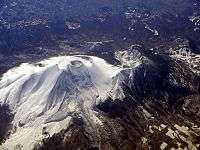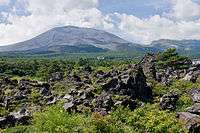Mount Asama
| Mount Asama | |
|---|---|
| 浅間山 | |
|
Viewed from the East | |
| Highest point | |
| Elevation | 2,550 m (8,370 ft) |
| Listing |
List of mountains and hills of Japan by height 100 famous mountains in Japan List of volcanoes in Japan |
| Coordinates | 36°24′N 138°31′E / 36.400°N 138.517°ECoordinates: 36°24′N 138°31′E / 36.400°N 138.517°E |
| Geography | |
| Topo map |
Geographical Survey Institute 25000:1 浅間山 50000:1 長野 |
| Geology | |
| Age of rock | Late Pleistocene–Holocene[1] |
| Mountain type | Complex volcano |
| Last eruption | June 2015 (ongoing) |
Mount Asama (浅間山 Asama-yama) is an active complex volcano in central Honshū, the main island of Japan. The volcano is the most active on Honshū.[2] The Japan Meteorological Agency classifies Mount Asama as rank A.[3] It stands 2,568 metres (8,425 ft) above sea level on the border of Gunma and Nagano prefectures. It is included in 100 Famous Japanese Mountains. A cruiser class of the Imperial Japanese Navy was named after it, including lead ship Asama.
Geology
Mount Asama sits at the conjunction of the Izu-Bonin-Mariana Arc and the Northeastern Japan Arc.[2] The mountain is built up from non-alkali mafic and pyroclastic volcanic rocks dating from the Late Pleistocene to the Holocene.[1] The main rock type is andesite and dacite.[4]

Scientists from University of Tokyo and Nagoya University completed their first successful imaging experiment of the interior of the volcano in April 2007. By detecting sub-atomic particles called muons as they passed through the volcano after arriving from space, the scientists were able gradually to build up a picture of the interior, creating images of cavities through which lava was passing deep inside the volcano.[5]
A University of Tokyo volcano observatory is located on the mountain's east slope. Volcanic gas emissions from this volcano are measured by a Multi-Component Gas Analyzer System, which detects pre-eruptive degassing of rising magmas, improving prediction of volcanic activity.[6]
Eruptive history
%2C_SRTM-1.jpg)
The geologic features of this active volcano are closely monitored with seismographs and strategically positioned video cameras.[7] Scientists have noted a range of textural variety in the ash which has been deposited in the region during the serial eruptions since the Tennin eruption of 1108.[8]
2009 eruptions
Mount Asama erupted in early February 2009, sending ash to a height of 2 km (6,600 ft),[9] and throwing rocks up to 1 km (5⁄8 mi) from the crater. Ash fall was reported in Tokyo, 145 km (90 mi) southeast of the volcano crater. On 16 February there were 13 recorded volcanic earthquakes and an eruption emitting smoke and ash in a cloud 400 m (1,300 ft) high.
Mount Asama continued to have small eruptions, tremors and earthquakes in February and remained on level-3 alert (with a danger zone within 4 km (2 1⁄2 mi) of the crater).[10]
2008 eruptions
Three small ash eruptions occurred at Asama volcano in August 2008. This was the first activity at the volcano since 2004.[7]
2004 eruption
A single vulcanian eruption occurred at Asama volcano at 11:02 UT on 1 September 2004. Incandescent blocks were ejected from the summit and caused many fires.[7] The eruption sent ash and rock as far away as 200 km (120 mi).[9]
1995 earthquakes
In April 1995, more than 1000 earthquakes were detected at the volcanic mountain.[7]
1983 eruptions
An explosive eruption occurred on 8 April. Incandescent tephra was ejected, and ash fell 250 km (160 mi) from the volcano.[7]
1982 eruption
Explosive eruptions occurred at the summit of Asama volcano on 26 April. Fine ash fell in Tokyo, 130 km (80 mi) to the SE, for the first time in 23 years.[7]
Tenmei eruption (1783)


Mount Asama erupted in 1783 (Tenmei 3), causing widespread damage.[11] The three-month-long plinian eruption that began on 9 May 1783, produced andesitic pumice falls, pyroclastic flows, lava flows, and enlarged the cone. The climactic eruption began on 4 August and lasted for 15 hours,[12] and contained pumice falls and pyroclastic flows.[7] The complex features of this eruption are explained by rapid deposits of coarse pyroclastic ash near the vent and the subsequent flows of lava; and these events which were accompanied by a high eruption plume which generated further injections of pumice into the air.[13]
Isaac Titsingh's account of the Asama-yama eruption was posthumously published in French in Paris in 1820;[14] and an English translation was published in London in 1822.[15] These books were based on Japanese sources; and the work represented first of its kind to be disseminated in Europe and the West.[16]
The volcano's devastation exacerbated what was already known as the "Great Tenmei Famine". Much of the agriculturally productive land in Shinano and Kōzuke provinces would remain fallow or under-producing for the next four or five years.[17] The effects of this eruption were made worse because, after years of near or actual famine, neither the authorities nor the people had any remaining reserves.[18] The 4 August eruption killed up to 1,400 people,[19] with an additional 20,000 more deaths caused by the famine.[20]
Tennin eruption (1108)
The eruption of Mount Asama in 1108 (Tennin 1) has been the subject of studies by modern science.[21] Records suggest that the magnitude of this plinian eruption was twice as large as that of the Tenmei catastrophe in 1783.[22]
Marking the span of Japan's history
The eruptions of Mount Asama mark the span of Japan's recorded history, including: 2009, 2008, 2004, 2003, 1995, 1990, 1983, 1982, 1973, 1965, 1961, 1958–59, 1953–55, 1952, 1952, 1950–51, 1949, 1947, 1946, 1944–45, 1938–42, 1935–37, 1934, 1934, 1933, 1931–32, 1930, 1929, 1929, 1927–28, 1924, 1922, 1920–21, 1919, 1918?, 1917, 1916, 1915, 1914, 1909–14, 1908, 1908, 1907, 1907, 1906, 1905?, 1904, 1903, 1902, 1902, 1900–01, 1899, 1899, 1894, 1889, 1879, 1878?, 1875, 1869, 1815, 1803, 1803, 1783, 1779?, 1777, 1776, 1769, 1762, 1755, 1754, 1733, 1732, 1731, 1729, 1729, 1728, 1723, 1723, 1722, 1721, 1720, 1719, 1718, 1717, 1711, 1710, 1708–09, 1706, 1704, 1703, 1669, 1661, 1661, 1660, 1659, 1658, 1657, 1656, 1655, 1653, 1652, 1651, 1650?, 1649, 1648, 1648, 1647, 1645, 1644, 1609, 1605, 1604, 1600, 1598, 1597, 1596, 1596, 1595?, 1591, 1590, 1532, 1528, 1527, 1518, 1427?, 1281, 1108, 887, 685.[7]
Note: The dates of eruptions featured in this article appear in bold italics.
Gallery
.jpg) Viewed from the South
Viewed from the South Viewed from the SSE.
Viewed from the SSE..jpg) Viewed from the North
Viewed from the North
See also
- Asama Volcano Museum
- List of Special Places of Scenic Beauty, Special Historic Sites and Special Natural Monuments
- List of volcanic eruptions by death toll
Notes
- 1 2 "Hokuriku". Seamless Digital Geological Map of Japan. Geological Survey of Japan, AIST. 2007. Retrieved 2 February 2009.
- 1 2 "Asama". Global Volcanism Program. Smithsonian Institution. Retrieved 2 February 2009.
- ↑ "List of Active Volcanoes in Japan". Quaternary Volcanoes in Japan. Geological Survey of Japan, AIST. 2006. Retrieved 3 February 2009.
- ↑ "ASAMA-YAMA". Quaternary Volcanoes in Japan. Geological Survey of Japan, AIST. 2006. Retrieved 3 February 2009.
- ↑ http://adsabs.harvard.edu/abs/2007E&PSL.263..104T
- ↑ "Real-Time Multi-GAS sensing of volcanic gas composition: experiences from the permanent Etna and Stromboli networks, Geophysical Research Abstracts, Vol. 11, EGU2009-5839" (PDF).
- 1 2 3 4 5 6 7 8 VolcanoLive.com: Asama
- ↑ Yasui, Maya, Takahashi Masaki, and Sakagami Masakuki. "Textural Variety in the Eruptive Products of Vulcanian Eruptions between 1108 A.D. and 2004 A.D. on Asama-Maekake Volcano," Bulletin of the Volcanological Society of Japan (Kazan). Vol. 50, No. 6 (2005). pp. 501–517.
- 1 2 "Volcano erupts close to Tokyo," BBC. 2 February 2009.
- ↑ 18 February 2009.
- ↑ Titsingh, Isaac. (1834). Annales des empereurs du japon, p. 420.
- ↑ Richards, John F. (2003). The Unending Frontier: An Environmental History of the Early Modern World. University of California Press. p. 177. ISBN 9780520939356. Retrieved 2 August 2013.
- ↑ Yasui, Maya and Takehiro Koyaguchi. "Sequence and eruptive style of the 1783 eruption of Asama Volcano, central Japan: a case study of an andesitic explosive eruption generating fountain-fed lava flow, pumice fall, scoria flow and forming a cone," Journal Bulletin of Volcanology (Kasan). Vol. 66, No. 3 (March 2004). pp. 243–262.
- ↑ Titsingh, Isaac. (1820). Mémoires et Anecdotes sur la Dynastie régnante des Djogouns, Souverains du Japon.
- ↑ Titisngh, Isaac. (1822). Illustrations of Japan: consisting of private memoirs and anecdotes of the reigning dynasty of the Djogouns, or sovereigns of Japan.
- ↑ Screech, T. (2006), Secret Memoirs of the Shoguns: Isaac Titsingh and Japan, 1779–1822, pp. 146–148.
- ↑ Hall, John. (1955). Tanuma Okitsugu, 1719–1788: Forerunner of Modern Japan, p. 122.
- ↑ Hall, p. 170.
- ↑ Stoltman, Joseph P.; Lidstone, John; Dechano, Lisa M. (11 March 2007). International Perspectives on Natural Disasters: Occurrence, Mitigation, and Consequences: Occurrence, Mitigation, and Consequences. Springer. pp. 172–73. ISBN 9781402028519. Retrieved 2 August 2013.
- ↑ Bowman, John Stewart (2000). Columbia Chronologies of Asian History and Culture. Columbia University Press. p. 185. ISBN 9780231110044. Retrieved 2 August 2013.
- ↑ Centre national de la recherche scientifique (CNRS), France: Yoshida, Minoru and Aoyagi, Ryugi. "Fluorine and chlorine contents in the products of the 1108 (Tennin) eruption of Asama volcano," Bulletin of the Volcanological Society of Japan (Kazan). Vol. 49, No. 4 (2004). pp. 189–199.
- ↑ Hayakawa, Yukio and Hideko Nakajima. "Volcanic Eruptions and Hazards of Asama Written in Historical Records" (abstract), Bulletin of the Volcanological Society of Japan (Kazan). 19 July 2006.
References
- Hall, John Whitney (1955). Tanuma Okitsugu, 1719–1788: Forerunner of Modern Japan, Cambridge: Harvard University Press.
- Hayakawa, Yukio and Hideko Nakajima. "Volcanic Eruptions and Hazards of Asama Written in Historical Records" (abstract), Bulletin of the Volcanological Society of Japan (Kazan). 19 July 2006.
- Screech, Timon (2006). Secret Memoirs of the Shoguns: Isaac Titsingh and Japan, 1779–1822. London: RoutledgeCurzon. ISBN 978-0-7007-1720-0 (cloth); ISBN 978-0-203-09985-8 (electronic)
- Titsingh, Isaac (1834). [Siyun-sai Rin-siyo/Hayashi Gahō, 1652], Nipon o daï itsi ran; ou, Annales des empereurs du Japon. Paris: Oriental Translation Fund of Great Britain and Ireland.
External links
| Wikimedia Commons has media related to Mount Asama. |
- Asamayama – Japan Meteorological Agency (Japanese)
- "Asamayama: National catalogue of the active volcanoes in Japan" (PDF). – Japan Meteorological Agency
- Asama Volcano – Geological Survey of Japan
- Asamayama – Smithsonian Institution: Global Volcanism Program
